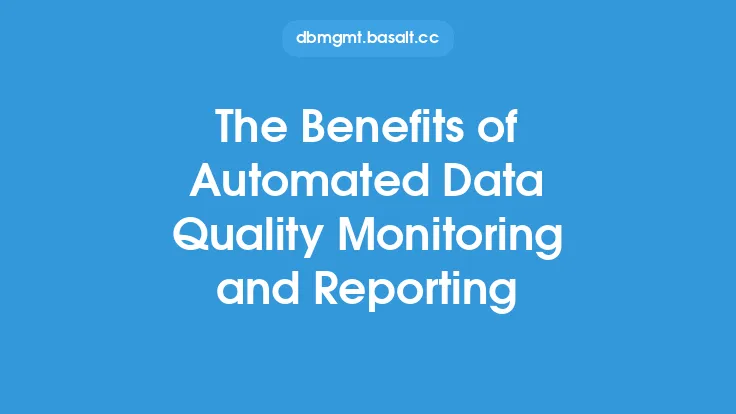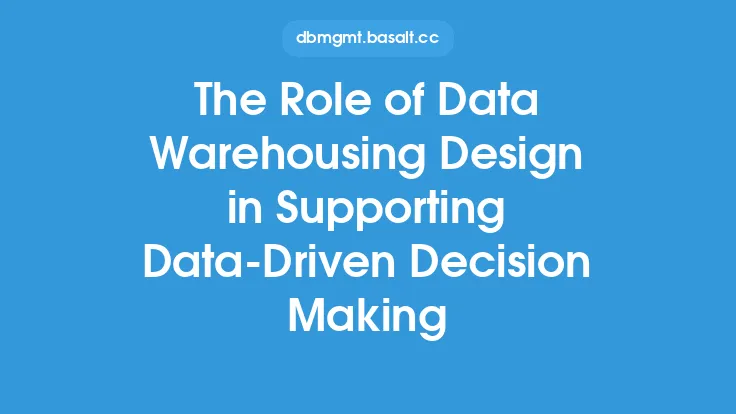Data warehousing has become an essential component of modern business intelligence, enabling organizations to make informed decisions by providing a centralized repository of data. The primary purpose of a data warehouse is to store data in a way that makes it easily accessible for analysis and reporting. By integrating data from various sources, a data warehouse provides a unified view of an organization's data, allowing for more accurate and comprehensive analysis.
Introduction to Data Warehousing
Data warehousing involves the process of designing, building, and maintaining a repository of data that can be used for analysis and reporting. A data warehouse is typically a relational database that is optimized for querying and analyzing large datasets. The data is usually extracted from various sources, such as transactional databases, log files, and external data sources, and then transformed and loaded into the data warehouse. This process is known as ETL (Extract, Transform, Load).
Benefits of Data Warehousing
The benefits of data warehousing are numerous, and they can be summarized as follows:
- Improved data analysis: Data warehousing enables organizations to analyze large datasets and gain insights that would be difficult to obtain from transactional databases.
- Enhanced reporting: Data warehousing provides a centralized repository of data that can be used to generate reports and dashboards, enabling organizations to make informed decisions.
- Increased data quality: Data warehousing involves the process of data cleansing and data transformation, which helps to improve the quality of the data.
- Better data governance: Data warehousing provides a single version of the truth, enabling organizations to establish a common understanding of their data.
Data Warehousing Architecture
A typical data warehousing architecture consists of the following components:
- Source systems: These are the systems that provide the data for the data warehouse, such as transactional databases and log files.
- ETL tools: These are the tools used to extract, transform, and load the data into the data warehouse.
- Data warehouse: This is the repository of data that is used for analysis and reporting.
- Data marts: These are smaller repositories of data that are used for specific business areas or departments.
- Reporting tools: These are the tools used to generate reports and dashboards from the data warehouse.
Data Warehousing and Business Intelligence
Data warehousing is a critical component of business intelligence, enabling organizations to make informed decisions by providing a centralized repository of data. Business intelligence involves the process of analyzing data and presenting it in a way that is easy to understand, using tools such as reports, dashboards, and data visualization. Data warehousing provides the foundation for business intelligence, enabling organizations to analyze large datasets and gain insights that would be difficult to obtain from transactional databases.
Best Practices for Data Warehousing
To get the most out of data warehousing, organizations should follow best practices, such as:
- Define clear goals and objectives: Before building a data warehouse, organizations should define clear goals and objectives, such as improving data analysis and reporting.
- Choose the right technology: Organizations should choose the right technology for their data warehouse, such as a relational database or a cloud-based data warehouse.
- Design a scalable architecture: Organizations should design a scalable architecture that can handle large datasets and high query volumes.
- Implement data governance: Organizations should implement data governance policies and procedures to ensure that the data is accurate, complete, and secure.
Common Data Warehousing Challenges
Despite the benefits of data warehousing, there are several challenges that organizations may face, such as:
- Data quality issues: Data warehousing requires high-quality data, and poor data quality can lead to inaccurate analysis and reporting.
- Data integration challenges: Integrating data from various sources can be challenging, especially if the data is in different formats or has different structures.
- Scalability issues: Data warehouses can become large and complex, making it challenging to scale the architecture to handle high query volumes.
- Security and compliance: Data warehouses contain sensitive data, and organizations must ensure that the data is secure and compliant with regulatory requirements.
Future of Data Warehousing
The future of data warehousing is exciting, with new technologies and trends emerging, such as:
- Cloud-based data warehousing: Cloud-based data warehousing is becoming increasingly popular, enabling organizations to build and deploy data warehouses quickly and cost-effectively.
- Big data and analytics: The increasing amount of big data is driving the need for advanced analytics and data warehousing solutions.
- Artificial intelligence and machine learning: Artificial intelligence and machine learning are being used to improve data analysis and reporting, enabling organizations to gain deeper insights from their data.
- Data warehousing as a service: Data warehousing as a service is becoming increasingly popular, enabling organizations to build and deploy data warehouses without the need for extensive IT resources.





